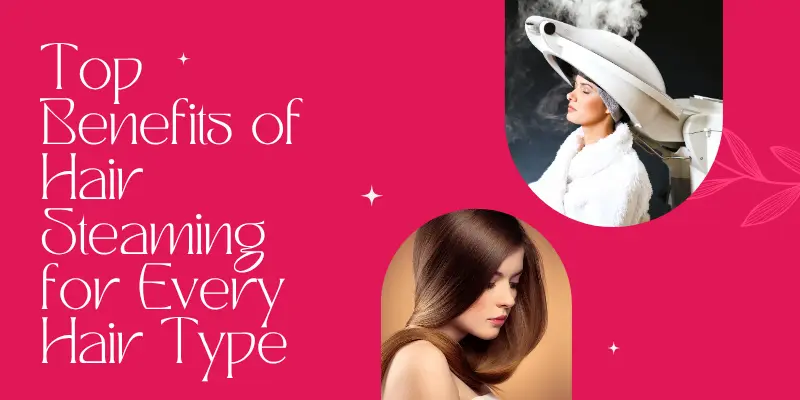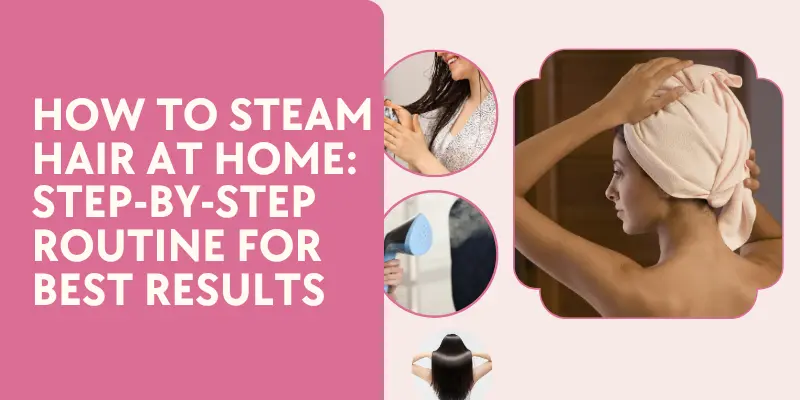Hair Steaming Benefits- The Ultimate Guide to Hydrated, Healthier Hair
Published: 24 Jun 2025
Hair steaming benefits go beyond surface-level shine. This simple heat-based treatment can transform dry, brittle strands into soft, hydrated hair. Using moist heat, it opens the cuticle for better product absorption, boosts hair elasticity, and improves scalp health. Whether your hair is curly, color-treated, or low porosity, steaming enhances moisture retention and strengthens your strands from root to tip. It’s easy to do at home and works for almost every hair type. In this guide, we break down the top benefits of hair steaming, provide a step-by-step guide on how to steam your hair, and offer the best tips to lock in moisture long after the steam has faded.
1. Understanding Hair Steaming: What It Is and How It Works
Hair steaming is a deep conditioning technique that utilizes moist heat to open the hair cuticle, allowing moisture, nutrients, and treatments to penetrate deeply into the hair shaft. Unlike dry heat from flat irons or blow dryers, steam delivers hydration, making it ideal for restoring and maintaining healthy hair. Many experts recommend adding it to any hair care guide for its ability to boost moisture and overall hair health.
What Is Hair Steaming?
At its core, hair steaming involves exposing your hair to warm vapor, either through a professional steamer or DIY methods like a hot towel. The process creates a humid environment that softens the hair cuticle (the outer layer), allowing conditioners and treatments to soak in more effectively. It also helps lift impurities from the scalp, creating the perfect foundation for healthier growth.
A Quick Look at Its Origins
Hair steaming has been a part of traditional beauty practices for centuries. Ancient cultures, especially in Africa and Asia, used herbal steam infusions and hot towels as part of natural haircare routines. Over time, professional salons adopted this technique using electric steamers, and today, it’s a popular self-care ritual embraced globally, especially by those with textured, dry, or damaged hair.
How Does Steam Affect Hair and Scalp?
The science behind steaming is simple yet effective. When steam surrounds your hair:
- The cuticle lifts, allowing moisture, oils, and nutrients to enter the hair shaft.
- Circulation increases, improving blood flow to the scalp, which can stimulate hair follicles.
- The scalp softens, loosening dirt, buildup, and dead skin cells for easier cleansing.
- Elasticity improves, reducing breakage and making strands more flexible and manageable.
2. Top Benefits of Hair Steaming for Every Hair Type
Hair steaming goes beyond surface-level conditioning; it works from within to rejuvenate the hair and scalp. Whether you have curly, straight, wavy, coily, or chemically-treated hair, this treatment offers a range of benefits that target common hair concerns.

Here’s how hair steaming can elevate your routine and transform your strands:
1. Deeply Moisturizes Dry and Brittle Hair
Steam opens the hair cuticle, allowing water and treatment products to penetrate the cortex of the hair shaft. This results in intense hydration, especially beneficial for dry or porous hair that struggles to retain moisture.
2. Enhances Product Absorption
By lifting the cuticle layer, steaming allows conditioners, oils, and masks to absorb more effectively. This means your hair gets the full benefit of the ingredients, not just a surface-level coating.
3. Improves Hair Elasticity and Reduces Breakage
Properly hydrated hair is more elastic, meaning it can stretch without snapping. Steaming helps improve flexibility and strength, which reduces split ends and breakage over time.
4. Promotes a Healthier Scalp
The warmth from the steam boosts blood circulation in the scalp, encouraging the delivery of nutrients to hair follicles. It also loosens debris, dead skin, and product buildup, keeping your scalp clean, balanced, and ready for healthy growth. Especially people with dry hair often wonder how to treat a dry scalp, and steam therapy can be an effective dry scalp treatment to restore moisture and comfort.
5. Encourages Hair Growth
A nourished, well-circulated scalp creates the ideal environment for hair growth. While steaming isn’t a direct hair growth treatment, it supports the conditions needed for stronger, longer hair over time.
6. Revives Natural Curls and Coils
For textured hair types, steaming helps restore bounce and definition by rehydrating curl patterns. It softens the strands, making detangling easier and styling more manageable.
7. Detoxifies the Hair and Scalp
Steam helps to lift out toxins, pollutants, and leftover product residue from the scalp and strands. This detox effect allows your hair to breathe and prevents issues like buildup-related itchiness or flakiness.
8. Boosts Shine and Smoothness
As moisture infuses the hair, strands become smoother, softer, and naturally shinier. Regular steaming helps eliminate dullness, making hair look healthier and more vibrant.
3. Is Hair Steaming Right for You? Who Should Try It (and Who Shouldn’t)
Hair steaming offers a wide range of benefits, but, like any treatment, it’s not a one-size-fits-all solution. Before adding it to your routine, it’s important to know if your hair type and condition are suited for steaming. Let’s break down who should embrace hair steaming and who might want to proceed with caution.
Who Should Try Hair Steaming
Anyone with dry, damaged, or frizzy hair, or those seeking deeper moisture and healthier strands.
1. People with Dry, Brittle, or Damaged Hair
If your hair feels rough, looks dull, or breaks easily, steaming can help replenish lost moisture and restore strength. It deeply hydrates and improves elasticity, making brittle hair more flexible and less prone to breakage.
2. Curly, Coily, and Natural Hair Types
Textured hair often struggles to retain moisture due to its spiral shape. Steaming helps rehydrate curls, reduce frizz, and make styling easier by softening the hair shaft and enhancing curl definition.
3. Individuals with Low Porosity Hair
Low porosity hair has tightly closed cuticles, making it difficult for moisture and products to penetrate. Steam gently opens the cuticle, improving the effectiveness of deep conditioners and treatments.
4. Anyone with Product Buildup or a Dry Scalp
Steaming helps loosen product buildup, dirt, and dead skin on the scalp. This makes cleansing more effective and reduces issues like itchiness or flakes.
5. Color-Treated or Chemically Processed Hair
Coloring, bleaching, and relaxing treatments can leave hair damaged and dehydrated. Steaming revives over-processed strands by improving moisture absorption and minimizing further breakage.
Who Should Avoid or Limit Hair Steaming
People with scalp infections, severe dandruff, or very fine hair are prone to breakage.
1. People with Scalp Conditions (like Eczema or Psoriasis)
Excessive heat and moisture may worsen scalp inflammation or irritation in sensitive individuals. Always consult a dermatologist before trying steaming if you have scalp conditions.
2. Those with High Porosity Hair (in Excess)
While steaming is generally safe, high porosity hair already absorbs moisture quickly. Over-steaming may cause protein loss or over-hydration, leading to mushy, weak strands. Use steam sparingly and follow with protein-rich treatments.
3. Fine or Thin Hair Types
Very fine hair may become limp or overly soft after steaming If you fall into this category, use lightweight products and reduce steaming frequency to avoid weighing the hair down.
4. Individuals Prone to Heat Sensitivity
If your scalp or hair is sensitive to heat, even mild steam may cause discomfort or damage. Test a short session first and adjust the temperature and time accordingly.
Pro Tip:
Hair steaming is not meant to replace regular deep conditioning; it enhances it. Use it as a booster to your routine, not a daily ritual. Listen to your hair and adjust based on how it responds.
5. Essential Tools and Products for an Effective Hair Steaming Session
To get the most out of your hair steaming routine, having the right tools and products is crucial. While you don’t need a salon setup at home, using the correct equipment and treatments can dramatically enhance results, helping your hair absorb more moisture, nutrients, and care.
4. Hair Steaming Tools: What You Can Use
You don’t need fancy equipment to steam your hair. A hooded steamer is great for even heat, while handheld steamers are perfect for targeting specific areas.

You can also use a warm towel and shower cap for a simple DIY method. Steam caps and facial steamers work, too. Just make sure your hair stays moist and covered to trap the heat.
1. Hooded Hair Steamer (Electric)
Ideal for: Deep treatments, even steam distribution, hands-free experience.
This professional-style steamer surrounds your entire head, delivering consistent warm steam. It’s perfect for those who want a salon-quality experience at home. Some models even include adjustable settings for steam intensity and time.
2. Handheld Hair Steamer
Ideal for: Targeted steaming, small spaces, and travel use.
A portable option that allows you to direct steam exactly where needed. It’s great for spot treatments or refreshing curls between wash days.
3. Hot Towel Method (DIY-Friendly)
Ideal for: Beginners or those on a budget.
Soak a clean towel in hot water, wring it out, and wrap it around your hair. Cover with a plastic cap and a warm towel, or use a thermal cap to trap the heat. While less intense, it still opens the cuticle and promotes product absorption.
4. Thermal Hair Cap or Microwaveable Cap
Ideal for: Heat retention and convenience.
These reusable caps are warmed in a microwave and worn over your hair, boosting the effect of your conditioner with gentle heat.
Best Hair Products to Use When Steaming
Hydrating masks, deep conditioners, and natural oils like coconut, argan, or olive oil.
1. Deep Conditioners or Hair Masks
Look for formulas rich in natural oils, humectants (like glycerin or honey), proteins (like keratin or silk), and moisture-binding agents. Choose products based on your hair needs: hydration, repair, strength, or curl definition.
2. Oils and Butters
For sealing in moisture or pre-treatment, lightweight oils like argan, jojoba, or grapeseed work best. For high-density moisture, shea butter or coconut oil may be used, especially for thicker textures.
3. Protein Treatments (Use Occasionally)
If your hair feels limp or overly soft, a protein-based treatment can restore strength. However, always follow it with moisture to maintain balance.
4. Scalp Treatments (Optional)
If you’re steaming to detox your scalp, apply a gentle exfoliating scalp treatment or oil (like tea tree or peppermint oil) before steaming to enhance circulation and loosen buildup.
Tips for Choosing the Right Products:
- For dry or damaged hair: Focus on hydrating masks with aloe vera, panthenol, or ceramides.
- For color-treated hair: Choose color-safe products with no sulfates or parabens.
- For curly/coily hair: Go for rich, creamy products that encourage curl definition.
- For fine hair: Use lightweight, non-greasy products to avoid weighing hair down.
5. How to Steam Hair at Home: Step-by-Step Routine for Best Results
Steaming your hair at home doesn’t require salon-level expertise or expensive tools. With the right approach, you can achieve soft, hydrated, and manageable hair from the comfort of your bathroom.

Here’s a simple, effective step-by-step guide to steaming your hair for optimal results.
Step 1: Start with a Clean Slate – Wash Your Hair
Before steaming, it’s essential to cleanse your hair and scalp. Use a gentle, sulfate-free shampoo to remove dirt, oil, and product buildup. This allows the steam and treatments to penetrate better and prevents sealing in unwanted residue.
Pro Tip: If you have a dry scalp, try a moisturizing or exfoliating shampoo for added benefits.
Step 2: Towel-Dry and Section Your Hair
After washing, gently blot your hair with a microfiber towel to remove excess water. Your hair should be damp, not soaking. Then, divide it into 4–6 sections using clips or bands. This ensures even product application and streaming across all areas.
Step 3: Apply a Deep Conditioner or Treatment Mask
Choose a deep conditioning treatment suited to your hair needs, hydrating, strengthening, curl-defining, or repair-focused. Apply it generously from roots to ends, paying extra attention to dry or damaged areas.
Optional: Add a few drops of nourishing oils like argan, avocado, or olive oil to boost the treatment.
Step 4: Begin the Steaming Process
Now it’s time to let the steam do its magic. Depending on the tools you have, here are your options:
- Hooded Steamer: Sit under the steamer for 15–25 minutes.
- Handheld Steamer: Slowly move the device around your head for 15–20 minutes.
- Hot Towel Method: Wrap your head in a hot, damp towel, cover it with a plastic/shower cap, then layer with a warm towel or heated cap for 20–30 minutes.
Keep the temperature comfortable, not too hot to avoid scalp sensitivity.
Step 5: Cool Down and Rinse
After steaming, let your hair cool for about 5 minutes to close the cuticle and seal in the moisture. Then rinse thoroughly with cool or lukewarm water to lock in hydration and remove any leftover product.
Step 6: Follow Up with Leave-In or Oil
To maintain the moisture gained from steaming, apply a lightweight leave-in conditioner or natural oil (like jojoba or almond oil) to seal your strands. Style as desired.
Quick Steaming Routine Checklist:
- Clean hair
- Damp, sectioned strands
- Deep conditioner or mask applied
- 15–30 minutes of steaming
- Cool rinse + leave-in/moisture seal
6. Different Methods to Steam Hair at Home (With or Without a Steamer)
You don’t need a salon to experience the benefits of hair steaming. Whether you have a professional steamer or prefer simple at-home hacks, there are several ways to steam your hair effectively. Below are the most common and accessible methods to suit different budgets, hair needs, and lifestyles.
1. Using a Hooded Hair Steamer
Best for: Deep conditioning, even steam distribution, and regular use
How it works:
A hooded hair steamer is an electric device with a dome-shaped hood that fits over your head. Once turned on, it releases consistent steam to cover your entire scalp and hair evenly. Simply sit under the hood for 15–25 minutes after applying your deep conditioner or treatment.
Pros:
- Professional results
- Covers all hair sections evenly
- Hands-free and comfortable
Cons:
- More expensive upfront
- Requires space and a power source
2. Handheld Hair Steamer
Best for: Spot treatment, convenience, travel
How it works:
A handheld steamer resembles a compact hairdryer. You manually move it across sections of your hair after applying conditioner. The nozzle directs steam to specific areas, allowing for targeted hydration.
Pros:
- Lightweight and portable
- Budget-friendly option
- Good for refreshing curls or treating specific areas
Cons:
- Requires effort to hold and move
- It may not be ideal for full-head steaming
3. DIY Hot Towel Method
Best for: Beginners, no tools required, low-cost option
How it works:
Soak a towel in hot (not boiling) water, wring it out, and wrap it around your conditioned hair. Cover it with a plastic/shower cap to trap the moisture. For extra heat, wrap a second warm towel over the cap or wear a thermal heat cap.
Pros:
- Easy and cost-effective
- No electric equipment needed
- Gentle on the hair
Cons:
- Less consistent heat
- Steam may cool quickly
4. Microwaveable Thermal Cap
Best for: Gentle heat retention and convenience
How it works:
A gel-filled or flaxseed cap that’s microwaved to generate warmth. After applying your conditioner and putting on a shower cap, wear the thermal cap for 20–30 minutes. It helps mimic steam by heating and opening the hair cuticle.
Pros:
- Reusable and easy to use
- Great for multitasking
- Doesn’t require cords or plugs
Cons:
- Doesn’t produce real steam
- Heat retention fades after a while
5. Steam Shower Method (Quick Refresh)
Best for: Mild hydration and curl refresh between wash days
How it works:
Apply conditioner or leave-in to your hair and sit in a steamy shower (without rinsing right away). Let the humidity do the work for about 10–15 minutes.
Pros:
- Requires no extra tools
- Great for weekly maintenance
- Works well for curls needing a moisture boost
Cons:
- Limited control over steam intensity
- Less effective than direct steaming
Choosing the Right Method:
| Your Need | Recommended Method |
| Salon-quality results | Hooded hair steamer |
| On a budget | Hot towel method |
| Travel or space-saving | Handheld steamer |
| No steam but deep heat | Microwaveable cap |
| Quick, low-effort refresh | No steam, but deep heat |
7. How Often and How Long Should You Steam Your Hair?
Hair steaming is incredibly beneficial, but like all good things, it works best in moderation. The frequency and duration of hair steaming depend on your hair type, condition, and goals. Overdoing it can lead to overhydration or weakened strands, while steaming too little may not deliver noticeable results. Here’s how to find the perfect balance.
How Long Should You Steam Your Hair?
The ideal steaming time is 15 to 30 minutes per session. This gives your hair enough time to absorb moisture and nutrients from your deep conditioner or mask without overwhelming the strands or scalp.
- 15–20 minutes is sufficient for fine, low-density, or slightly dry hair.
- 25–30 minutes works better for coarse, thick, curly, or damaged hair.
Avoid steaming longer than 30 minutes unless using a low-heat thermal cap, as too much heat can cause swelling of the hair shaft, making it vulnerable to breakage.
How Often Should You Steam Your Hair?
Here’s a breakdown based on hair type and condition:
Dry, Brittle, or Damaged Hair
Recommended: Once a week
Steaming weekly helps restore hydration, reduce breakage, and improve elasticity. Pair with a moisturizing mask or repairing conditioner for best results.
Curly, Coily, or Natural Hair
Recommended: Every 1–2 weeks
These hair types benefit from frequent moisture. Steaming helps define curls and soften texture without disrupting natural oils.
Low Porosity Hair
Recommended: Every 1–2 weeks
Since low porosity hair struggles to absorb moisture, steaming helps lift the cuticle so products can penetrate. Just don’t overdo it; alternate with protein treatments when needed.
Color-Treated or Chemically Processed Hair
Recommended: Twice a month
Steaming helps repair chemically treated strands by restoring lost moisture and strengthening the structure. Be sure to use color-safe, sulfate-free products during your session.
Fine or Oily Hair
Recommended: Once a month (or as needed)
Too much moisture can make fine hair limp or greasy. Steam sparingly and choose lightweight products to avoid buildup.
What About Steaming Temperature?
Always ensure the steam is warm, not hot. You should feel gentle heat, but never discomfort. Excess heat can cause scalp irritation or damage the hair cuticle. Many electric steamers allow you to adjust the temperature and keep it on a moderate setting.
Quick Guidelines:
| Hair Type | Frequency | Duration |
| Dry/Damaged | Weekly | 25–30 mins |
| Curly/Coily | 1–2 times/month | 20–30 mins |
| Low Porosity | Bi-weekly | 20–25 mins |
| Color-Treated | 2x/month | 20–25 mins |
| Fine/Oily | Monthly | 15–20 mins |
Signs You’re Oversteaming:
- Hair feels overly soft or mushy
- Increased breakage
- Loss of curl definition
- Scalp irritation or excess oiliness
If you notice any of these, reduce frequency or steaming time and alternate with protein treatments to restore balance.
8. Dos and Don’ts of Hair Steaming: Avoid These Common Mistakes
Hair steaming can transform dry, dull hair into soft, healthy strands if done correctly. While the process is simple, certain missteps can lead to damage or reduce the effectiveness of your routine. Follow these essential dos and don’ts to make the most of every steaming session.
Dos of Hair Steaming
Use moderate heat, apply nourishing products, and limit sessions to once a week for best results.
1. Start with Clean Hair
Always wash your hair before steaming. Steaming over dirty hair traps buildup, oil, and residue, which can block moisture and nutrients from penetrating the strands.
2. Do Use the Right Deep Conditioner or Treatment
Choose a moisture-rich, sulfate-free conditioner or hair mask tailored to your hair type. For best results, look for ingredients like shea butter, aloe vera, glycerin, panthenol, and natural oils.
3. Do Steam in Sections
Dividing your hair into sections helps distribute the treatment evenly and ensures each part of your hair gets exposed to steam.
4. Do Protect Your Hairline and Scalp
Apply a thin layer of oil or moisturizer around your edges and scalp if you’re using high heat or have sensitive skin. This prevents irritation and dryness.
5. Do Use a Shower Cap or Steaming Cap
When using a towel or thermal cap method, always cover your hair with a plastic or shower cap first. This traps steam, enhances heat penetration, and prevents dripping.
6. Do Follow Up with a Cool Rinse
After steaming, rinse your hair with cool or lukewarm water to close the cuticle and lock in moisture. This step also boosts shine and reduces frizz.
7. Do Moisturize and Seal
Apply a leave-in conditioner or lightweight oil after rinsing to retain hydration and prolong the effects of your steam treatment.
Don’ts of Hair Steaming
Avoid steaming too often, using overly hot steam, or applying harsh chemicals before the treatment.
1. Don’t Steam Too Often
More isn’t always better. Oversteaming can lead to overhydrated, mushy strands that are prone to breakage. Stick to your recommended frequency based on hair type.
2. Don’t Use High Heat Directly on the Scalp
Direct high heat can irritate your scalp or cause burns. Always ensure steam is at a safe, warm temperature, not hot.
3. Don’t Skip Prepping Your Hair
Steaming won’t work well if your hair is tangled or covered in old product. Always detangle and clarify before your session.
4. Don’t Mix Too Many Products
Using multiple conditioners, oils, and treatments at once can weigh your hair down or cause buildup. Stick to one targeted product per session.
5. Don’t Leave Steam on Too Long
Extended steam exposure weakens the hair shaft and opens the cuticle excessively. Limit each session to 15–30 minutes max.
6. Don’t Expect Instant Hair Growth
While steaming improves scalp health and supports growth, it’s not a miracle solution. Use it as part of a long-term healthy haircare routine.
7. Don’t Ignore Protein Balance
If your hair feels too soft or spongy after steaming, it might be time for a protein treatment. Steaming adds moisture, but balance is key.
9. Post-Steaming Hair Care: Locking in Moisture and Maintaining Results
Steaming infuses your hair with deep hydration, but what you do after the session matters just as much. Without proper follow-up care, all that moisture can evaporate or leave your strands unprotected. This section walks you through the essential post-steaming steps to seal in moisture, maintain softness, and protect your hair long term.
1. Cool Rinse to Seal the Cuticle
After steaming, your hair cuticles are open. To lock in the moisture and nutrients from your treatment, rinse your hair with cool or lukewarm water. This helps flatten the cuticle layer, boosts shine, reduces frizz, and traps hydration inside the hair shaft.
Avoid hot water during the rinse- it can strip moisture and reopen the cuticle.
2. Apply a Leave-In Conditioner
Once excess water is squeezed out (gently, using a microfiber towel or T-shirt), apply a leave-in conditioner. This adds an extra layer of moisture and protection, keeping your hair soft and manageable throughout the week.
Choose a lightweight, silicone-free leave-in for fine or low-density hair, and richer creams for curly, coily, or dry textures.
3. Seal with Oil or Butter
To prevent moisture loss, seal your strands with a natural oil or butter. This step is especially important for porous or textured hair that loses hydration quickly, making it a key part of any effective textured hair care routine.
Recommended sealing oils:
- Argan oil – adds shine and smoothness
- Jojoba oil balances the scalp and seals without heaviness
- Coconut oil – deeply nourishing (for non-protein-sensitive hair), especially when you apply coconut oil at night to let it absorb fully and repair your strands while you sleep.
- Shea butter – ideal for thick or coily hair
- Apply a small amount from mid-lengths to ends to avoid greasy roots.
4. Detangle Gently (If Needed)
Steamed hair is softer and more elastic, making it easier to detangle. Use a wide-tooth comb or your fingers to gently work through knots, starting from the ends and working your way up.
Never force the comb-steamed hair is delicate and can snap under tension.
5. Style and Protect
After locking in moisture, style your hair as usual. Whether you’re doing twists, a wash-and-go, or straightening, the post-steaming stage is the perfect time for your hair to be at its most hydrated and responsive.
If you plan to apply heat, always use a heat protectant spray to avoid undoing the hydration benefits.
6. Nighttime Protection
To preserve your results overnight:
- Sleep on a satin or silk pillowcase
- Use a satin/silk bonnet or scarf to reduce friction
- Put your hair in a loose braid or pineapple to maintain style and shape
These steps prevent moisture loss and tangling while you sleep.
7. Maintain Moisture Between Steams
In the days following your steam session, maintain hydration with:
- Light daily moisturizers or refresher sprays
- Mid-week co-washing or misting, especially for curly/coily textures
- Avoiding heat tools and harsh styling products
Conclusion
Hair steaming is more than just a trendy treatment’s a powerful, moisture-boosting ritual that transforms the health and appearance of your hair. Whether you’re dealing with dryness, frizz, or breakage, adding steam to your routine can deeply hydrate, soften, and revive your strands from root to tip. With the right tools, techniques, and post-care, steaming can benefit every hair type and texture. Start small, stay consistent, and let the gentle power of steam unlock your hair’s true potential.
FAQs,
You can steam your hair at home by wrapping damp, conditioned hair with a hot towel. Cover it with a shower cap to trap heat and leave it on for 20–30 minutes. The warmth opens up the hair cuticles, allowing moisture and nutrients from conditioners or oils to penetrate deeply. This method is simple, cost-effective, and doesn’t require a professional steamer. Regular steaming helps maintain softness, shine, and manageability over time.
Yes! Steaming hydrates hair, making it softer, smoother, and shinier. It also helps deep conditioners and oils absorb more effectively. The warm steam increases scalp circulation, promoting healthier hair growth. Over time, consistent steaming can improve hair elasticity, reduce frizz, and prevent dryness. It’s a gentle, natural way to nourish both your hair and scalp.
If you don’t have a hair steamer, you can use the hot towel method or sit in a steamy shower after applying a deep conditioner. Both techniques help open hair cuticles, allowing treatments to penetrate better. They are quick, affordable, and easy to do in your bathroom. Using these methods regularly can replicate salon-like hydration without expensive tools.
You can mix natural ingredients such as aloe vera, honey, coconut milk, yogurt, or oils with your conditioner before steaming. These ingredients provide extra moisture, strengthen hair, and enhance shine. The steam helps them penetrate deeply into your hair strands. Customizing ingredients to your hair type ensures maximum nourishment and health benefits.
If you steamed with a conditioner or mask, rinse with cool water to lock in moisture. Shampooing afterward isn’t always necessary unless your hair feels heavy or sticky. Rinsing helps maintain softness while keeping the hydration intact. Using cool water closes the hair cuticles, sealing in nutrients and preventing frizz. This step ensures your hair looks smooth and healthy.
Aloe vera can be combined with coconut oil, honey, or a deep conditioner to make a powerful moisturizing blend. This mixture nourishes the scalp, strengthens hair strands, and improves elasticity. It’s suitable for all hair types, including dry, frizzy, or damaged hair. Using it during steaming ensures that the nutrients penetrate deeply, giving long-lasting softness and shine.
Yes! Applying light oils such as argan, avocado, or jojoba oil before steaming helps seal in moisture. Oils also soften hair, reduce frizz, and enhance shine. The heat from steaming allows the oil to penetrate deeper into the hair shaft. Avoid heavy oils if your hair is fine, as they can weigh it down. Regular pre-steaming oil treatments improve overall hair health.
Steam your hair for 15–30 minutes to allow products to deeply hydrate strands and improve elasticity. Steaming for too long can weaken hair or cause overhydration, so sticking to this time range is ideal. After steaming, gently rinse or leave in oils/conditioners as needed. Consistent sessions every 1–2 weeks help maintain softness and manageability.
No, daily steaming can overhydrate hair, making it weak and prone to breakage. Limit steaming to once a week or once every two weeks depending on your hair type. Overdoing it can disturb the natural oil balance of your scalp. Regular but moderate steaming ensures hydration without causing damage. Always monitor how your hair responds and adjust frequency accordingly.
Yes! Steaming improves moisture retention, elasticity, and overall hair strength. Hydrated hair is less likely to snap or break during combing or styling. Regular steaming combined with deep conditioning can reduce split ends and brittleness over time. It’s a gentle way to strengthen hair while maintaining softness, shine, and smoothness.

- Be Respectful
- Stay Relevant
- Stay Positive
- True Feedback
- Encourage Discussion
- Avoid Spamming
- No Fake News
- Don't Copy-Paste
- No Personal Attacks

- Be Respectful
- Stay Relevant
- Stay Positive
- True Feedback
- Encourage Discussion
- Avoid Spamming
- No Fake News
- Don't Copy-Paste
- No Personal Attacks





